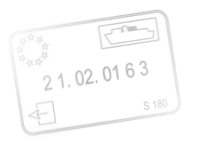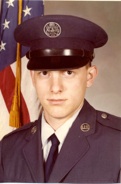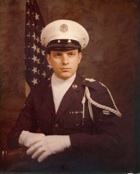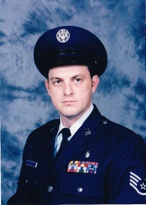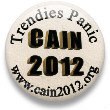Richard N. Cain took the Oath of Enlistment and joined the United States Air Force on his seventeenth birthday, in October of 1977. After completing Basic Military Training he attended the Medical Administrative Specialist course at the School of Health Care Science at Sheppard AFB Texas. Upon completion of this course he was assigned to USAF Medical Center Keesler, Keesler AFB, in Biloxi Mississippi. His first duty assignment was in the Orthopedics Clinic as an appointment clerk and receptionist. While serving in this capacity, on 21 April 1978 he received the GED with scores well above the national average in all areas.
In June of 1978 he was reassigned to the Otolaryngology Services as Administrative Specialist. His duties included maintenance of the clinic appointment system, receptionist, dispatching, distributing and sorting mail, and preparing statistics and reports as directed by the NCOIC. While performing these duties he also completed his five-level Career Development Course, and became a member of the Keesler Honor Guard. He performed these duties until April of 1980 when he was reassigned to the Outpatient Records section of the Medical Center. His performance on the Keesler Honor Guard earned him a Letter of Appreciation from the Non Commissioned Officer in Charge (NCOIC) of the Keesler Honor Guard.
His duties in Outpatient Records included filing miscellaneous medical documents, backup coverage for the Medical Center Information Desk, and night shift supervisor. His diligence and tireless efforts were directly responsible for reducing the enormous backlog of medical documents awaiting filing. His expertise in the management of the outpatient records portion of the base mobility plan was to a great degree directly responsible for base mobility exercises being upgraded from marginal to an acceptable rating. During this period he also completed the Supervisors Safety Training course, the Air Force Effective Writing course, Professional Military Education (PME) Phase I, and earned six semester hours of college level English credit through the CLEP General Exam.
In June of 1982 he was reassigned to the Admissions and Dispositions Office at Keesler Medical Center. He was responsible for the proper procedures concerning the admission and disposition of patients using the Registration/Admission Disposition Transfer (R/ADT) automated system. This included patient transfers to and from the facility, patients placed on the SI/VSI roster, death cases, quarters, and carded for record only cases, insuring the Admissions and Disposition list was correct, and distribution of the A & D list. During this time frame he completed Phase II PME, Extension Course Institute (ECI) course 51151, Computer Programming; and completed College Algebra I earning 3 semester hours credit.
In April 1984 he was reassigned to USAF Clinic Ankara, Ankara Turkey as Non-Commissioned Officer in Charge (NCOIC) of Medical Resource Management. His duties required him to compute and compile data for the Uniform Staffing Methodologies, Uniformed Chart of Accounts, and the Report of Patients. He also keypunched data from these reports for transmission to Headquarters USAFE. Other duties included alternate Medical Service Account officer and responsibility for all aspects of the clinic computer system, which had sit idle prior to his assignment. During his tour at Ankara he developed computer programs for Resource Management activities as well as other clinic functions. He completed the Uniform Chart of Accounts course, at Sheppard AFB, ECI course 51171 Programming Technician, Principles of Management and Astronomy 201 college level courses, earned his seven level rating, and attended the 1985 USAFE Medical Resource Management Workshop. He also assisted the Air Postal Squadron at Ankara after duty hours to help distribute the tremendous amounts of mail to the American community, receiving a Letter of Appreciation from the Base Commander for his efforts. Other off duty activities included membership in the Local Apple Users Group whose membership included Turkish Nationals as well as members from the American community. This enabled him to represent the Air Force in a positive manner and learn more about the customs and people of Turkey as well.
In April 1986 he was reassigned to the Medical Resource Management Office at Keesler Medical Center as NCOIC Management Analysis. His duties required him to automate much of the Data Collection and Reporting aspects of the Office along with conducting internal inspections of other areas. This included developing a Temporary Duty (TDY) tracking program that resulted in a reduction of seventy-five percent of the man hours required to track TDY expenditures. He also developed a program to track weekly supply issues more accurately, a program that allowed the Resource Management Officer to project fund targets on a weekly basis, and a program to track occupied bed days by ward and service. He developed a program that tracks Pharmacy procedures by the Medical Expense Performance Reporting System code, which produced an accurate amount of the money spent by each account code. He completed the WordStar, Lotus 1-2-3, and dBase II Familiarization course, conducted by the 3300 Technical Training Wing at Keesler AFB. He also received a Letter of Appreciation for participation as a Key person in the 1987 Air Force Assistance Fund Campaign.
In July of 1987 when the position became available, he was assigned to the Medical Systems Office as NCOIC, Medical Systems. His duties there required him to provide support and training for over one hundred microcomputers, provide operations support on an as needed basis for six minicomputer systems providing support for over twelve hundred users, and served on the Medical Centers ADPE planning committee as an advisor. Many times his duties required him to pull 24hr shifts to ensure appropriate coverage. From September 1988 until October of 1989 he was the Apple computer Sales Representative for the Base Exchange. He also served as a volunteer Medical Red Flag II Instructor from 12 March 1987 to 18 October 1987, thus insuring that Hospital personnel were prepared to meet their Wartime as well as Natural Disaster duties. Some of his other accomplishments was the creation of Lotus spreadsheets to track workload and supply expenditures, development of a personnel dBase II program to track key information on all Medical Center personnel deploying for REFORGER ‘87, conducting an internal Control Review of over thirty microcomputer systems to insure security requirements and user needs were being met, converted Genetics data into graphics presentations to enhance the ability to interpret data, installed and taught the use of microcomputer software and hardware resulting in more efficient and effective users. As the Small Computer Manager for the Medical Center, he did an outstanding job in processing all the documents required to purchase over eighty Z-248 microcomputers, forty Data General microcomputers critically needed by the Medical Center, a Compact Disk System for the Medical Genetics department, several Apple Macintosh workstations required by the Nuclear Medicine department, managing the microcomputer security program which received an excellent rating on the Health Services Management Inspection (HSMI). In April of 1989 his Officer in Charge (OIC) made the following comment, “I have received more compliments on SSgt Cain than any other person on my staff. His ability and knowledge far exceeds that of his peers and these skills will provide tremendous benefits in tomorrows Air Force. SSgt Cain has unlimited potential and should definitely be promoted at the earliest opportunity.” During his tenure in the Medical Systems Office he completed the Medical Systems Officer Symposium for 1987 and 1988, Introduction to Oracle for Developers course, Enable Familiarization Course, Block III Equipment Management course, and Accounting I at the Jeff Davis Community College. In February of 1988 he attended the Noncommissioned Officer Leadership School as the Class First Sergeant.
In March of 1990, he was reassigned to the Operating Room of Keesler Medical Center to provide much needed microcomputer support. Although he was only assigned to the operating room for seven months he was able to streamline the operation of the computerized operating room log, providing an increase in the speed of processing and simplifying procedures for other personnel who were not as proficient with computers. His programming abilities enabled him to extract reports from the database which allowed the Department of Surgery to meet the JCAH requirements for reporting surgical procedures, as well as providing staff physicians with information required to meet the state certification boards. On September 6, 1990 he was awarded an Air Force Commendation Medal for his accomplishments and Meritorious Service at Keesler AFB.
In November of 1990, he was reassigned to the USAF Standard Systems Center at Gunter AFB, Alabama. While assigned there his duties were to implement the Expense Assignment System phase III (EASIII) computer system in Medical Facilities throughout the Air Force, training over one hundred and sixty personnel worldwide, and saving three hundred and thirty thousand dollars in maintenance costs. He modified the training outline, increasing trainer flexibility, and resolved numerous system problems which resulted in optimal and efficient use of the system. He developed the MEPM to EASIII personnel data conversion program that was used by all Air Force Medical Facilities to convert their current data to the new EAS III format, reducing the conversion time required at the facility level ninety-nine percent. He also developed a Financial Data management program that reduced user error rate by ninety-five percent, which prevented erroneous data submissions to the Department of Defense and increased fiscal accuracy. His efforts at bullet-proofing the data base build software installation program eliminated one hundred fifty reinstallation man-hours. He also worked to engineer the new EASIII Financial Pre-merge Subsystem to correct deficiencies, and avoided over ten thousand dollars in contractor costs.
In August of 1994, he was reassigned to the Resource Management Office of the 502d Medical Group at Maxwell AFB, Alabama as a Data Systems Analyst. His key duties, tasks, and responsibilities were to analyze systems capabilities and correct deficiencies in software programs. Act as primary on-site software expert for the EAS III system. Manage the 502d Medical Group Support Agreement program to insure that sixty-two support agreements were properly maintained and reviewed in accordance with regulatory requirements. Closely track all agreements during the coordination phase to insure all suspense’s were met in a timely manner. He also managed the safety program for Building 754 to verify areas and equipment were safe, and insure that all personnel were properly briefed on safety. Managed all supplies and $36,000 in equipment and computer systems for the Resource Management Office, and supervised one military and one civilian. Additional duties included Deputy Superintendent of Medical Resource Management, Alternate Medical Expense and Performance Reporting System (MEPRS) Manager, Alternate Alternative Care Program Manager, and Alternate Change Fund Custodian. Some of his accomplishments at the Medical Resource Management Office include, designing software to manage $899,000 Alternate Care Program which streamlined the data retrieval system used to process up to fifty inquiries per week, saving the program manager over 240 man-hours per year. At the request of the Standard Systems Center, he created a software program to resolve a problem with EASIII financial processing at Warner Robbins AFB, Georgia, which allowed the MEPRS Manager to bring the EASIII system back on-line and correct a three month backlog in data processing. He converted MEPRS time sheet productivity data on 550 personnel to a useable format that provided the Base Medical Management Engineering Team a useful tool to support the critical HQ USAF Capitation Budgeting Project. Automated the $151,000 Temporary Duty (TDY) Tracking Program, enhancing the management of Continuing Medical Education and other hospital funded TDYs, and saving the program manager over fifteen hours per month. This program allowed the budget personnel and Senior Executive Management to closely monitor TDY expenditures and usage. He upgraded software for collecting, storing, and reporting data for the Centrally Managed Allotment and Supplemental Care Programs, saving the Alternative Care Program Manager over forty man-hours per month. He developed a program to automatically convert all prior year program expense codes (PEC) on the Financial Data Disk to new PEC, saving the Budget Analyst and MEPRS Manager over fifty man-hours per month. He reduced the size of the monthly and quarterly management summaries without compromising data content or quality, saving over 400 man-hours per year in data entry and saving $500 a year in printing expenses. He also trained office personnel in the use of computer programs, allowing for more accurate processing of data and enhanced coverage of functional areas, filling a formal training void in the systems arena. In April of 1995, he attended the Senior Non-Commissioned Officers Leadership School at Tyndall AFB, Florida.
In July of 1996, he was reassigned to the Medical Information Systems office at Maxwell AFB, Alabama, where his duties included Manager of all medical information systems, including the Composite Health Care System (CHCS), Medical Expense and Performance Reporting System Version 3 (EASIII), Medical Network (MEDNET), and the AT&T 3B2 office automation system. These duties required him to troubleshoot, repair, and maintain 270 microcomputers, maintain and manage hardware and software maintenance contracts, and write ad hoc computer programs as required to satisfy user needs. He was also the Alternate Unit Computer Security Officer, Unit Control Center Team Member, and Non-Commissioned Officer of the Day (NCOD). He developed software to automate the hardware inventory process of the Medical Group computer systems and install software on all systems, saving approximately 400 man-hours annually. His software also backed up all critical systems files, to allow for easy recovery after user errors, and compiled data from individual systems inventories, which made the overall corporate inventory more accurate and timely. He also created software to automatically install required scripts for “SmarTerm 420” for the CHCS system, and Office Automation and Exchange Mail, a point and click operation which saved over 200 man-hours in installation. He created a program to inventory installed software on all unit personal computers, which allowed the Systems personnel an easy method to check for unauthorized copyrighted software. He developed software to correct errors in Civilian Pay data, saving 576 man-hours annually, and used by over twenty 42d Air Base Wing and Air University organizations. He assisted in the installation of over 100 copies of emulation software, 430 pieces of hardware, and 610 network cable drops to support the on-time activation of the Composite Health Care System. His OIC commented “Solid NCO with the knowledge and ingenuity to get the job done!”
On 1 December 1997, he retired from the United States Air Force with twenty years and one month of “Honorable” service. He also acquired an Associate in Applied Science Health Care Management degree through the Community College of the Air Force. For the next nine months he worked only his part time business as a sales representative at the Maxwell AFB Exchange, so that his three children could complete the school year.
In September of 1998 he took a position on the national help desk working for a contractor with the Indian Health Service. In this position his duties required him to trouble shoot user issues, and program errors for the Resource and Patient Management System (RPMS) applications. This included screening and testing the applications for Y2K errors, and identifying routines that required updating to correct for the Y2K date issue. He was eventually moved to an Analyst/Programming position where he worked on the Patient Registration Module of RPMS.
In June of 2001, he took a more challenging position with a Non-Profit Healthcare Organization in Eugene Oregon. As senior developer for the GE AES environment using DSM and Cache, he developed reporting applications, program routine libraries, and utilities for managing the AES environment. He automated the procedures required for performing monthly reporting and bookkeeping functions in the Flowcast environment, reducing the man-hours required by two thirds, and eliminating processing errors. He developed standards for in house program development in the AES environment, which along with improving software maintenance reduced the learning curve for new developers. During this time he also earned his Bachelor of Science in Information Technology, and his Master of Information Systems, degrees through the University of Phoenix.
In January of 2010, he announced that he was running for President of the United States of America. His announcement and other information regarding his campaign can be found at his official campaign website www.cain2012.org.
Throughout his professional career he has never been the President or CEO of a big corporation, instead his experience and practical knowledge made him the “Go To” guy that found the solutions to the problems and issues that upper management required. He has never run for, or held, a public office before, so he hasn't been corrupted into thinking that all solutions require “back room deals” or “spending large amounts of other peoples money”, to make a problem go away or increase the wealth of campaign contributors. His background and professional experience will provide him with the knowledge and skills that this nation needs to correct the decades of poor fiscal management, as well as the fraud, waste, and abuse, which has taken place in Washington.
In 2012, we need a President that has the knowledge and experience to find real solutions, and not just cheer and rally the public support for the ineffective solutions that are being offered by Congress. We need a President that will know when a proposed solution will not work for everyone. We need a President that will be able to provide the answers that Congress needs to find those solutions that will work for everyone, not just for big business and the wealthy few.

